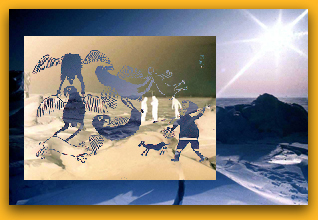
 |
 |
Inuit
Culture and |
|
In the early 1800's Peter may have drawn himself into the whaling trade, perhaps along with seal and salmon, and acted as a middleman with the northern baleen hunters (similar to the southern Inuit), who became an important source of his income. In order to communicate, he became knowledgeable in the Inuit language, adding a third language to his vocabulary. I feel that a person who wishes to live in a new country must be adventurous and inquisitive, similar to Peter, someone who enjoys a challenge within a new culture. During the late summer season, Peter may have joined an Innuit group of about 50 people in caribou hunting. As mentioned previously, there had been a clash between the maltreated Inuit and the Europeans, but I think Peter was more aware of the delicate situation and did not behave like an abusive, ignorant white settler towards the Inuit. I think he demonstrated respect for the natives and was able to gain the privilege of joining the Inuit caribou hunts into the interior from the late summer to the early spring. Not only was the western economy flourishing, but also the expansions of Moravian missions (Anglican religion) in the northern regions of Labrador made direct trading opportunities available to each hunter. Firearm possession was increasing among the Inuit, and supplies of powder and shot had to be replenished by trips to the south. At first the Moravian missionaries were unwilling to act as suppliers, but soon they realized that their reluctance only increased the number of trading journeys to the south (Garth Taylor, 1974). Unfortunately, problems among the natives began to accumulate as these new possessions (firearms) increased the economic dependence on European suppliers, and as the Inuit gradually abandoned their native traditional techniques like using the bow and arrow or spears.
A NEW FAMILY Not only do I believe Peter Leon was a survivor of the north and a learned man, but also that he may have decided to start a family of his own. Being quite fond of Inuit territory, he may have become involved with a young Inuit woman when he took part in the caribou expeditions. Intermarriages with Europeans in the early 1800's was not uncommon, reducing the number of pure Inuits. Even though monogamous marriages, or nuclear families composed of a man, his wife and their children, existed among the Inuit, most marriages were joint families because of the presence of more than two spouses. I am sure that Peter was aware of this kind of family structure, but he probably did not want any part of a joint family. His culture was more familiar with the patriarchal structure. I also feel that Peter kept his own religious faith as a Catholic, even though his wife had been exposed to the Moravian mission. Therefore, it is possible that he and his companion resided closer to the Quebec-Labrador Straits in St. Augustin, Quebec so that they could remain closer to his/her culture, beliefs, and language while still maintaining a reasonable living.
THE ADOPTION OF A NEW CULTURE Unfortunately, not knowing the first name, maiden name or place of birth of Peter Leon wife, little can be known for certain. I believe Peter's companion met her husband during the hunting season, and he possibly asked for her hand in marriage, as per European custom, from her parents. It is probable she was quite young due to the Inuit custom of marrying their daughters shortly after puberty. According to a book called In the Words of Elders, written by Peter Kulchyski, Don McCaskill and David Newhouse, the mother generally arranged these marriages. If the parents both agreed to this relationship, then the daughter had no choice. That was how it was done. Therefore, this is what I think happened to her after their matrimony. It is possible that Peter, being a skillful man of trade and with the help of the Moravian missionaries, gradually prepared his Inuit wife to take part in an emerging industrial world. However, the British also married native women during the 1800's and eventually adopted a subsistence mode of production that paralleled that of the Inuit and subsequently was incorporated into the Moravian settlements. |
|